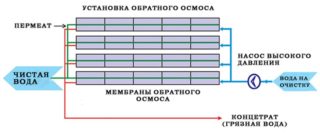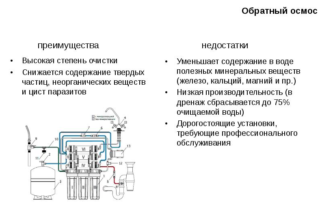Distilled water is often needed in industrial plants. This is especially true for the chemical, pharmaceutical, food and cosmetic industries. For water treatment, industrial reverse osmosis filters are used here, which purify water by 99.9%.
Application area
- beverage production - used to remove minerals and salts;
- production of medicines and cosmetics;
- chemical industry - reduces hydrocarbonate alkalinity;
- purification of bottled water;
- production of microelectronic elements;
- cleaning of household liquids and waste water;
- mechanical engineering;
- closed cycle processes.
Filtration using reverse osmosis has completely replaced ionic distillation from the market, which is several times higher than energy consumption.
Principle of operation
Chemical ions that are removed after cleaning:
- heavy metals;
- sodium;
- potassium;
- sulfates;
- chlorides;
- boron;
- fluorine.
The pore sizes of the membrane are equal to the sizes of water molecules. In reverse osmosis, it is possible to regulate the composition of trace elements. If the filtration process fails or the quality of the treated water deteriorates, the membrane block is forcibly blocked.
After the end of the filtration process, the purified water, called permeate, is related to waste water, or concentrate, as 2: 1. To obtain 1000 liters of purified liquid, the required delivery volume is approximately 1500 liters. From this volume of waste water will be 500 liters.
Types and arrangement of industrial installations
An industrial filtration system is a combination of technological devices, filtration blocks and valves. The main criterion that determines development is power. There are several types of osmosis:
- Installations of low productivity, filtering up to 5 cubic meters per hour. Of all the varieties, this is the most budgetary option, the membrane in them is located in one case. If the membrane is one, it is located vertically, if there are several, horizontally.
- Medium-sized structures filter seawater with high quality. They differ in the number of membrane elements present in two housings, which are located in parallel.
- The most powerful and most efficient version of industrial reverse osmosis contains additional load-resistant membranes to which the contaminated water is supplied. After filtration, 75% of the permeate remains. They are a complex technical object and are controlled by hardware.
Production requires a different volume of clean liquid, therefore, for each purpose, an individual selection of industrial reverse osmosis is required.
Criterias of choice
There is no single standard type of osmosis unit that would suit every enterprise. The filter is selected depending on the quality of the incoming water and the required performance. To choose which type of installation is needed, you need to:
- Based on the level of contamination of the incoming water, establish the required type of membranes and their number.
- In accordance with the capacity and the type of contamination, select the pump according to the performance parameters.
- Determine the type of equipment required for pre-filters.
You can choose an osmosis system only after specifying the initial parameters. One of the main selection criteria is the area of application of the permeate, since the chemical characteristics for different areas of industry can be diametrically opposed.
Advantages and disadvantages
An advantage can be considered the ability to vary the methods and degrees of water purification. There is a possibility to equip the device with an ultraviolet lamp, mineralizers or other devices required in production.
The disadvantage is the large percentage of permeate volume loss in relation to the supplied concentrate.
Reverse osmosis cannot hold certain types of ions. These include chlorine and herbicides.
The chemical composition of the permeate is depleted. The filtered liquid is harmless to humans, but also useless. It lacks all the nutrients and essential minerals.
Cost of equipment
Prices for industrial reverse osmosis plants are proportionally dependent on the required individual production characteristics. An installation with a capacity of 500 liters per hour can be purchased for less than 130 thousand rubles.
A foreign-made system that removes up to 98% of pollutants and 99% of unnecessary bacteria, with a capacity of 500 liters per hour and obtaining up to 40% of permeate, costs 140 thousand rubles and more.
A highly efficient industrial filter of Russian production with two membranes, with a capacity of 450 liters per hour, can be purchased from 145 thousand rubles.
Industrial reverse osmosis is widely used in a wide variety of industrial fields. Filtration of this type is considered the most versatile, efficient and promising.











